Key takeaways:
- Understanding workplace harassment policies is vital for empowering employees to speak up and ensuring a safe work environment.
- Gender equality advocacy enhances workplace culture, promotes collaboration, and improves employee morale and retention.
- Effective advocacy strategies include building strong networks, sharing personal stories, and using data to support initiatives.
- Assessing workplace policies through employee feedback and benchmarking against best practices drives improvement and clarity in addressing harassment.
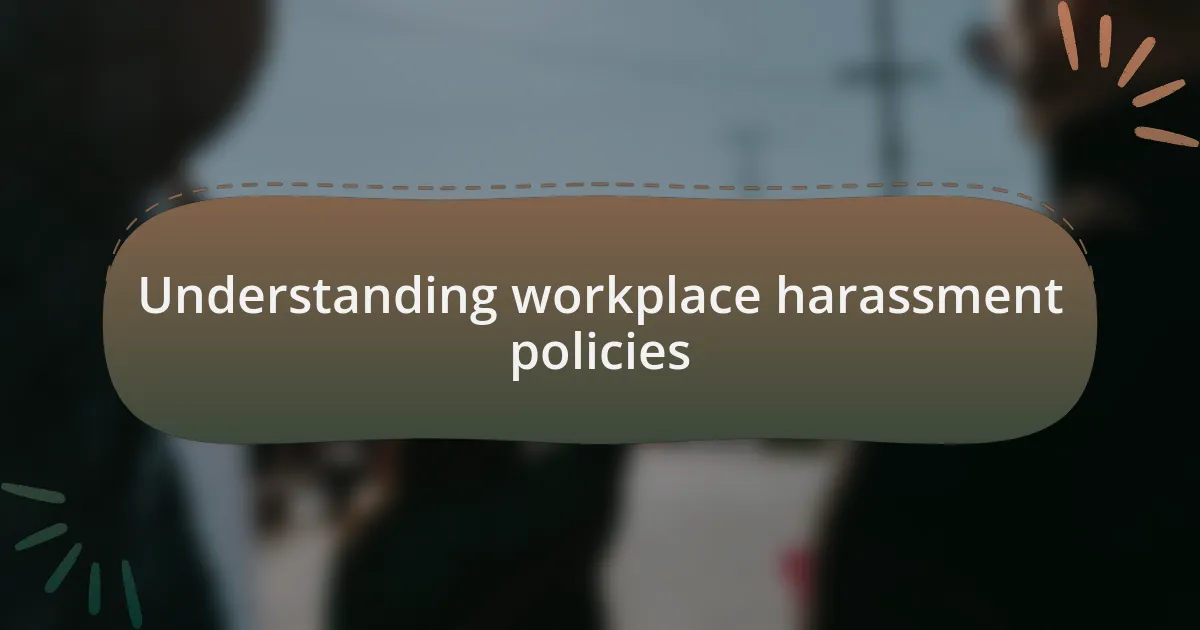
Understanding workplace harassment policies
Workplace harassment policies are designed to create a safe environment for all employees, but many people overlook their importance until they find themselves in a difficult situation. I remember a colleague who was hesitant to report harassment because she felt her concerns would be dismissed. This raises an important question: how can we ensure that everyone feels empowered to speak up?
Understanding the nuances of these policies is crucial. They often outline what constitutes harassment, the procedures for reporting it, and the potential consequences for violators. When I first delved into this topic, I was surprised to discover just how many employees were unaware of their rights and the protections available to them. Why should we leave anyone in the dark about something so vital?
Moreover, effective policies should not just reside in a dusty binder—they need to be actively communicated and upheld. I witnessed firsthand how a transparent policy empowered my team to foster an open dialogue about unacceptable behavior. Seeing individuals advocate for one another reinforced my belief that understanding these policies not only protects us but also strengthens workplace culture. Isn’t it time everyone became advocates for their own safety and the safety of their peers?
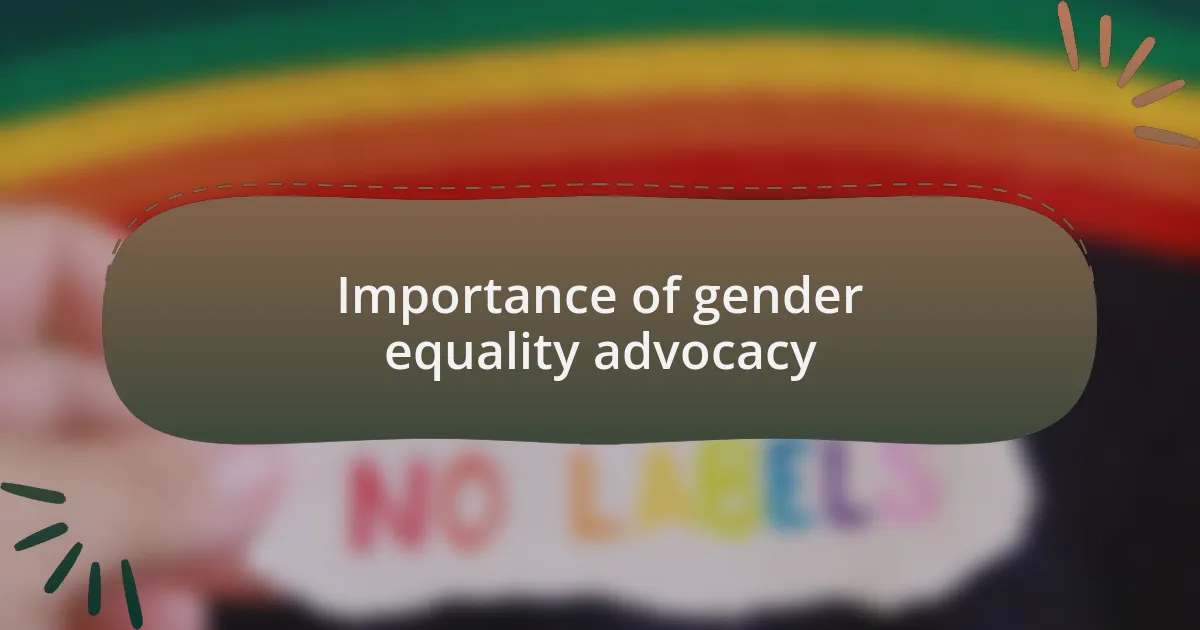
Importance of gender equality advocacy
Advocating for gender equality is essential because it fosters a culture where every voice matters. I still recall a time when my team worked on a project where input from everyone was encouraged. The diversity of thought contributed to more innovative solutions. When employees feel valued, they’re more likely to collaborate and bring their best selves to work. How can we expect to thrive in our roles if we don’t ensure an inclusive environment for all?
Moreover, gender equality advocacy creates a ripple effect beyond the workplace. I’ve seen companies that promote equality not only attract a wider range of talent but also boost employee morale significantly. It’s amazing how one gesture—like offering equal opportunities for leadership roles—can transform a workplace culture and encourage camaraderie among coworkers. Don’t we all want to work in places where our unique contributions are celebrated?
Ultimately, gender equality advocacy is about more than policies; it involves championing respect and understanding among colleagues. I once attended a workshop where we shared personal stories of overcoming bias; this shared vulnerability built bridges between team members. When we acknowledge our differences while advocating for equality, we pave the way for a more supportive and empowered workforce. Isn’t it time to invest in this kind of change?
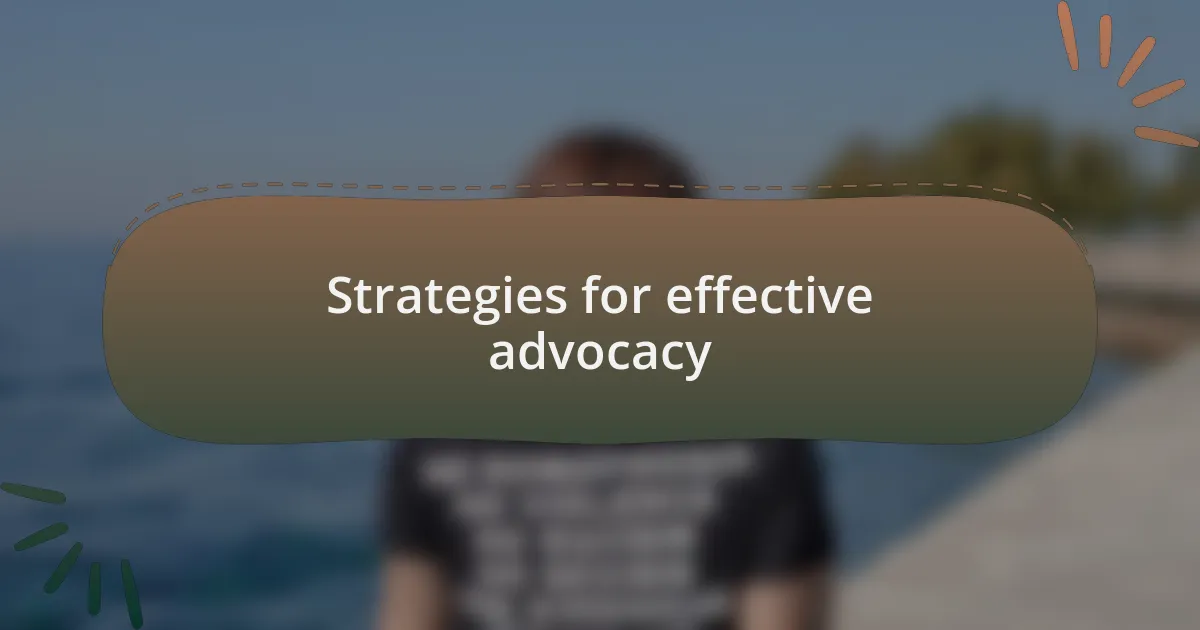
Strategies for effective advocacy
To foster effective advocacy, one of the strategies I’ve found useful is building strong networks. In my experience, collaborations unite diverse voices and amplify our messages; I remember a campaign where various organizations came together to address workplace harassment. Each group brought unique insights, helping to shape a more comprehensive approach that resonated across different departments. Isn’t it powerful when different perspectives combine to create a unified front?
Another key strategy is to share personal stories that humanize the issue. I once spoke at an event where I recounted my own experiences with workplace harassment. The audience’s reaction was profound; suddenly, the topic became less abstract and much more relatable. It’s interesting how vulnerability can break down barriers and encourage others to share their experiences, don’t you think?
Lastly, we must leverage data to back our advocacy efforts. I’ve seen how presenting compelling statistics about the effects of harassment on productivity can sway decision-makers. During a recent meeting, I shared data showing that workplaces prioritizing inclusivity not only retain talent but often outperform those that don’t. This kind of evidence can’t be ignored, right? By approaching advocacy with a blend of personal, emotional, and analytical strategies, we can create impactful change.
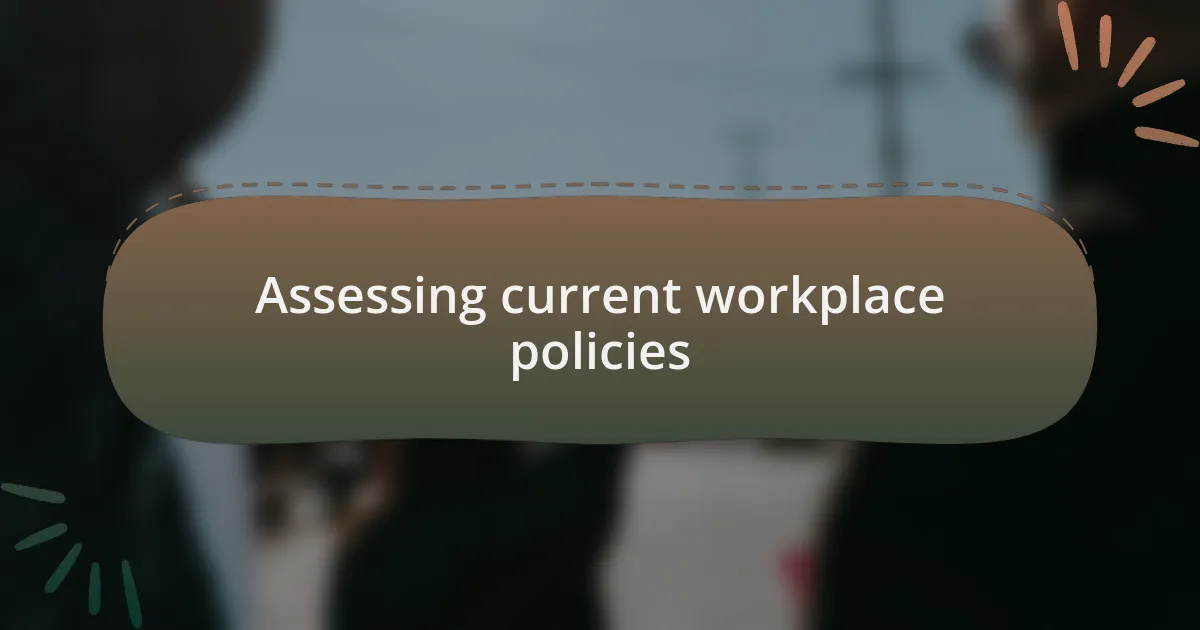
Assessing current workplace policies
Assessing current workplace policies requires a keen understanding of both the written guidelines and the lived experiences of employees. In my own experience, I’ve noticed that many policies sound impressive on paper but fail to resonate with the realities individuals face daily. For instance, during a workshop I attended, we reviewed a harassment policy that was vague and open to interpretation. This often left employees feeling confused about what constituted unacceptable behavior.
When assessing these policies, I found it crucial to gather feedback directly from staff. At one organization, I led a focus group that allowed employees to share their concerns about existing policies. Their candid feedback revealed areas where the policies fell short, emphasizing the need for clearer definitions and support systems. Isn’t it enlightening how directly engaging employees can shine a light on gaps that might go unnoticed otherwise?
Lastly, I advocate for benchmarking against best practices from other organizations. I recall a time when I looked into a company renowned for its robust anti-harassment measures. By comparing our policies to theirs, I could see both the strengths and weaknesses in our approach. This kind of comparative analysis not only provides insights but also drives motivation for continuous improvement. After all, why settle for mediocrity when we can strive for excellence in creating safe and supportive workplaces?
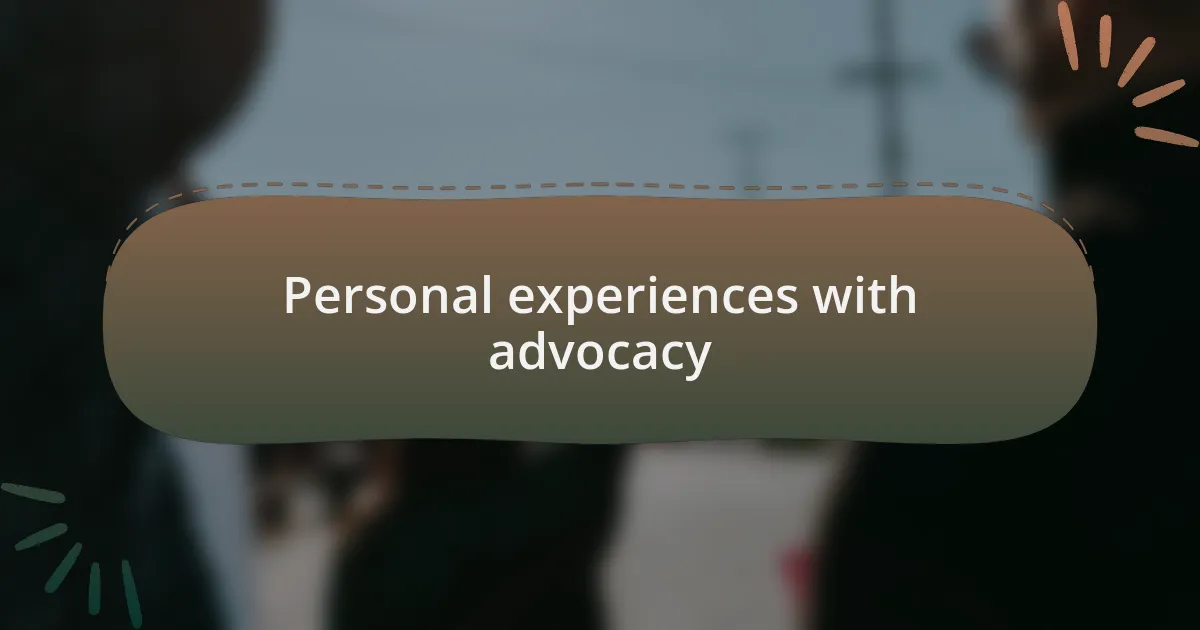
Personal experiences with advocacy
Personal experiences with advocacy have profoundly shaped my understanding of workplace dynamics. I recall a time when I led an advocacy initiative following a distressing event where a colleague faced harassment. It was heartbreaking to see how the existing policies failed her. Watching her struggle brought a sense of urgency to my advocacy work, compelling me to push for clearer definitions that not only resonated with staff but also empowered them to speak up.
During my advocacy journey, I realized the importance of storytelling. In one meeting, I shared a narrative about a friend’s experience with harassment and the subsequent fallout she encountered due to vague policies. This not only stirred emotions among the attendees but also sparked a lively discussion about the effects of ambiguity in guidelines. Have you ever shared a story that changed someone’s perspective? It was eye-opening to witness how personal experiences can elevate conversations beyond mere policy debates.
I also learned that building alliances can amplify advocacy efforts. Joining forces with colleagues who shared a passion for creating a safer workplace helped us develop a more comprehensive proposal for policy improvements. When we presented our ideas to management, we were able to represent a unified voice, showcasing not just individual concerns but a collective call for change. How powerful is the strength of unity in advocacy? It’s a reminder that by standing together, we can make a significant impact.
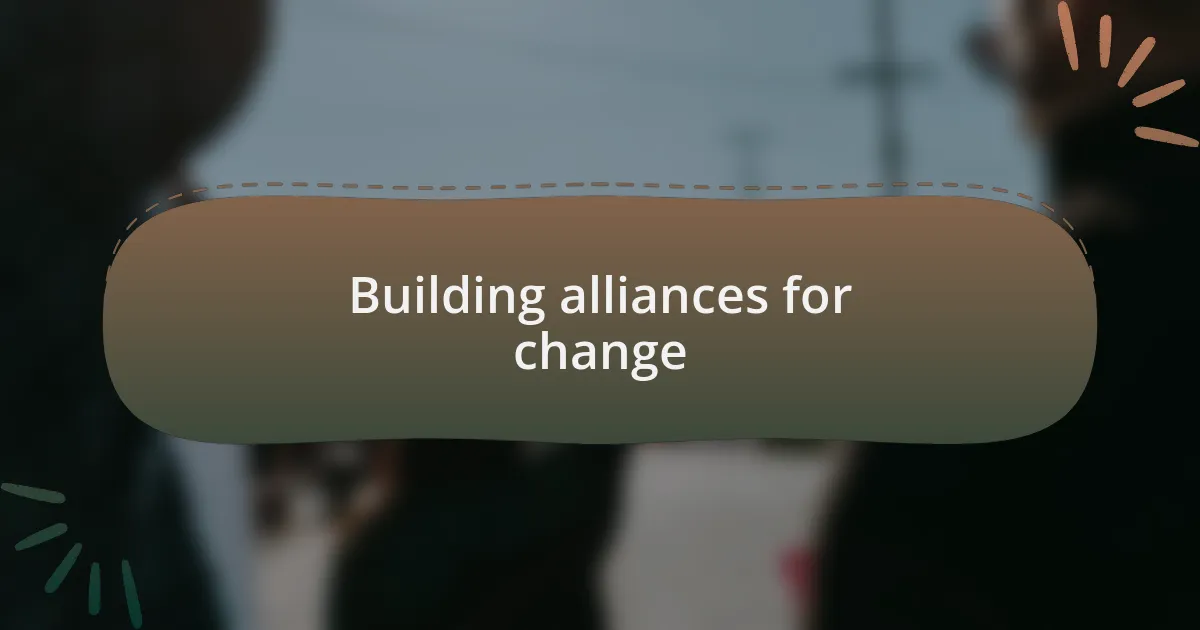
Building alliances for change
Working collaboratively with allies has been one of the most rewarding aspects of my advocacy journey. I remember attending a workshop where a colleague shared her approach to building networks within our organization. It struck me how her strategic alliances not only enhanced her credibility but also created a broader support system that validated our collective experiences. Isn’t it fascinating how shared goals can bridge gaps and forge unexpected connections?
One memorable experience involved collaborating with a grassroots organization dedicated to workplace equality. This partnership equipped us with additional resources and insights, allowing us to refine our policy proposals. When we co-hosted a lunch-and-learn session about harassment prevention, I witnessed firsthand the impact of diverse perspectives. Has a collaboration ever redefined your approach to a challenge? For me, it was a powerful moment that underscored how alliances can enrich advocacy efforts and lead to meaningful change.
In my view, the process of building these alliances is not just about shared objectives but about cultivating trust and understanding. I vividly recall the first meeting with our newly formed team, where we openly discussed our hopes and fears regarding workplace culture. That authenticity fostered a sense of camaraderie that propelled our efforts forward. How do you cultivate trust in your collaborations? For me, openness has been a vital ingredient in transforming discussions into actionable change.